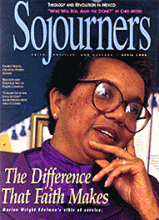We got off the 11th Street bus in downtown Washington and headed toward the people gathering on the 10th Street overpass. A man in his early 40s fell into step with us. As we approached the crowd, his breath caught. He began to cry. I reached over and held his shoulder, asking if he was all right. "No," he shook.
"There are so many people up there. I’m the only one I know...." He moved off under a tree, weeping.
The day was crisp, clear. November 11th. The crying man is a Vietnam veteran—G.I., officer, medic—a vet. My companion, Lorna, a visiting friend of my sister’s, is also a vet. A retired Army colonel, a nurse, she served in the 2nd Surgical MASH unit near Ahn Khe from 1966 to 1967. A slight woman in her mid 50s, she has silvering hair, a low melodious voice, sensible shoes, and a worn cable-knit sweater. We walked together toward the parade.
This particular Veterans Day brought nearly 50,000 people to Washington, D.C., for the installation of the Women’s Vietnam Memorial, the first memorial in the United States for women serving in war. Approximately 11,500 American military women served in country. Eight were killed on duty.
LORNA DIDN’T WANT to march in the parade. Just observe. Hand-drawn signs called units together: 85th Evac./Phu Bai ’70-’71; 3rd Field Hospital/Saigon ’72. A group of Navajo women vets in traditional dress wore their medals pinned to brightly ribboned blouses. Many women were in uniform, bush jackets with bits and pieces of the camouflage grays and greens. Some had the old phrase "Donut Dolly" taped to the back of their jackets.
Throughout the day a number of women called to Lorna from the crowd. They hugged. Exchanged stories. The women introduced husbands, showed pictures of children.
Along the parade route, men openly cried and saluted as the face of a woman they thought they might know suddenly crystallized with a long forgotten memory.
Read the Full Article
